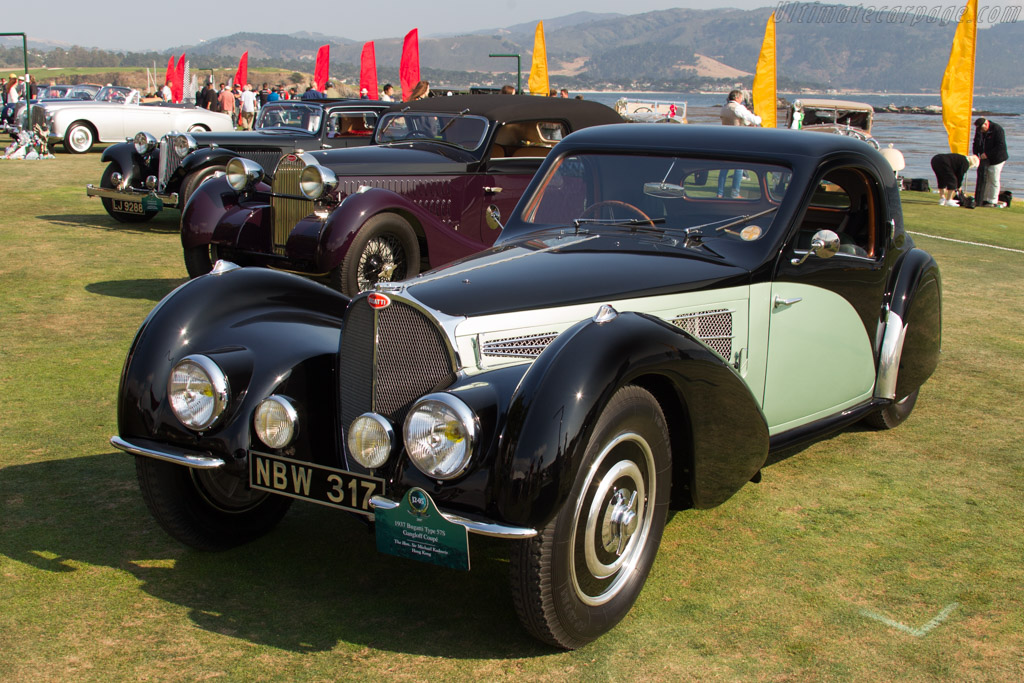1937 Bugatti Type 57 Gangloff Coupe

The descriptions of the Classic Cars in the Directory were partly generated or supplemented with the help of artificial intelligence (AI). The content may occasionally not always be entirely accurate or factually correct despite careful checking.
The Bugatti Type 57 Gangloff Coupe 1937 is a pristine example of the French automaker's dedication to performance and design. This stunning vehicle features a robust and innovative chassis, paired with a beautiful aesthetics and impeccable craftsmanship.
At the heart of this vehicle is a 3.3-liter engine, capable of generating 135 horsepower at 5000 RPM. This is an impressive feat for the time, and it speaks to Bugatti's commitment to providing their customers with the best possible driving experience.
The engine is mated to a four-speed manual transmission, which allows for smooth yet precise shifting. This gearbox is a testament to Bugatti's engineering prowess, and it contributes to the car's impressive handling and overall performance.
The body of the Type 57 Gangloff Coupe is a stunning work of art, with sleek lines and a beautiful flowing design. The car measures 4.8 meters in length, 1.6 meters in width, and 1.4 meters in height. These dimensions, combined with the vehicle's low-slung stance, give it an unparalleled sense of speed and agility.
The chassis of the Type 57 is just as impressive as the rest of the car, with a sturdy construction and advanced engineering that allows for outstanding maneuverability and stability. The vehicle features leaf-spring suspension at the front and rear, with hydraulic shocks that help to absorb any bumps or jolts that may be encountered during the course of a drive.
Stopping power in the Type 57 is provided by four-wheel hydraulic drum brakes, which are more than capable of bringing the car to a safe and controlled stop. These brakes are another example of Bugatti's engineering prowess, and they contribute to the Type 57's excellent overall performance.
Overall, the Bugatti Type 57 Gangloff Coupe 1937 is a truly exceptional vehicle that exemplifies the best of French automotive engineering and design. From the engine to the chassis to the body, every aspect of the car has been carefully crafted to provide an unparalleled driving experience that is sure to delight even the most discerning of automotive enthusiasts.
Milestones
- 1934: Development of the Bugatti Type 57 begins. - 1936: Bugatti Type 57 is officially released. - 1937: Gangloff Coachworks creates the Bugatti Type 57 Gangloff Coupe. - 1938: Bugatti Type 57SC Gangloff Coupe debuts at the Geneva Motor Show. - Late 1930s: Bugatti Type 57 Gangloff Coupe becomes a popular choice among wealthy car enthusiasts. - 1940s: Bugatti Type 57G tank becomes an icon in racing, winning multiple competitions. - 1950s: Additional modifications are made to the Bugatti Type 57, including a lowered chassis and increased horsepower. - 1960s: Bugatti Type 57 becomes a rare and highly sought-after collector's item. - 2009: Bugatti releases the modern version of the Type 57, known as the Bugatti Veyron.Technical
• Engine: 3.3-liter DOHC inline-eight • Horsepower: 135 hp • Transmission: Four-speed manual • Chassis: Steel ladder frame • Suspension: Front independent, Rear live axle • Brakes: Four-wheel hydraulic drum brakes • Dimensions: 186 inches (length), 69 inches (width), and 61 inches (height) • Wheelbase: 130 inches • Top Speed: 107 mph • Production Years: 1934-1940 • Body Style: Coupe • Body Designer: Jean Bugatti, coachwork by Gangloff • Number of Produced Units: An estimate of around 710 units • Fuel Delivery: Twin Zenith carburetors • Ignition: Coil and Distributor • Weight: 3,000 pounds • Tires: 5.50x18-inch tires • Steering: Worm and roller • Fuel Tank: 18-gallon capacity • Colors: Various options were available such as Black, Dark Blue, Light Blue, Grey, Green, Red, Ivory, and Brown • Features: Ventilated windshield, wire-spoked wheels, and exterior door handles that opened the suicide-style doors.